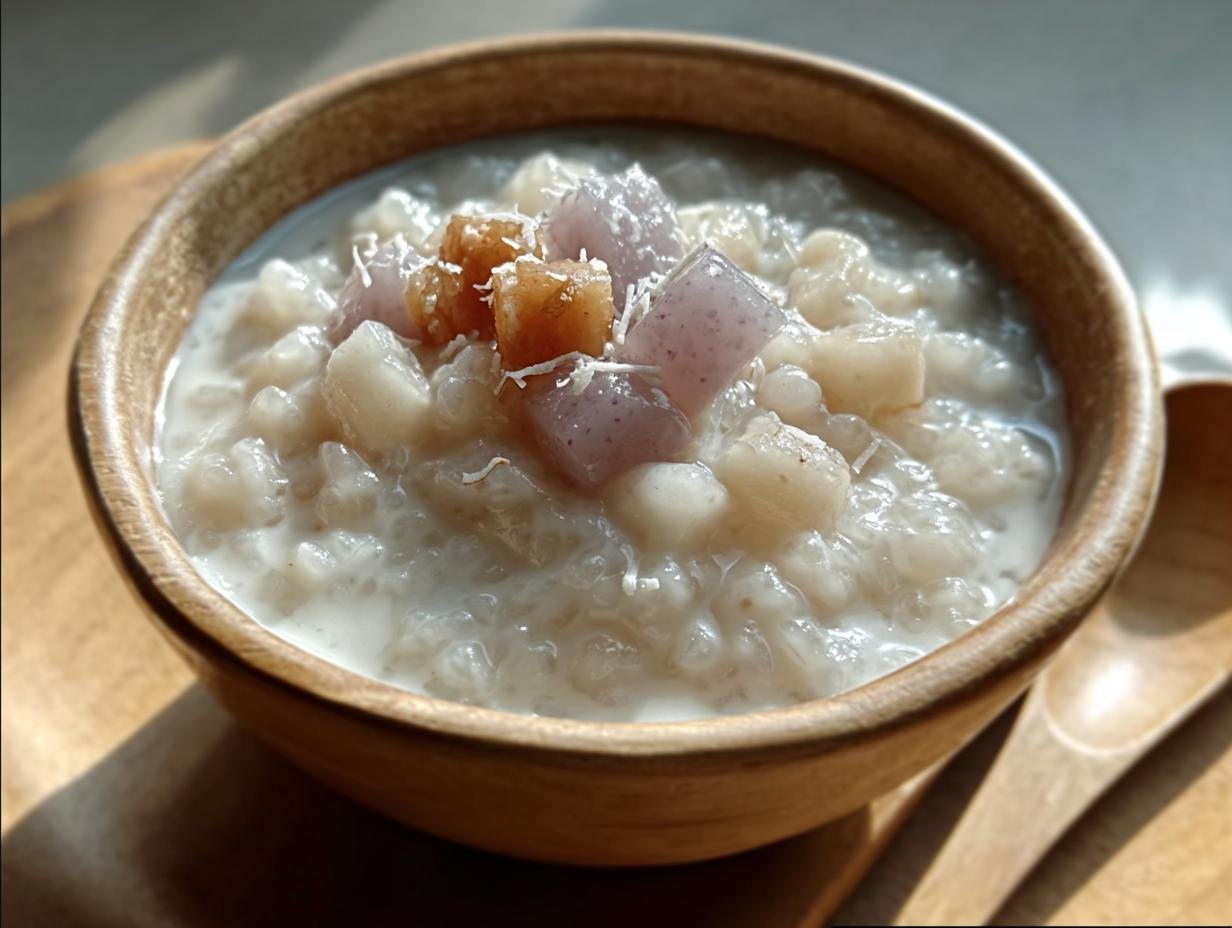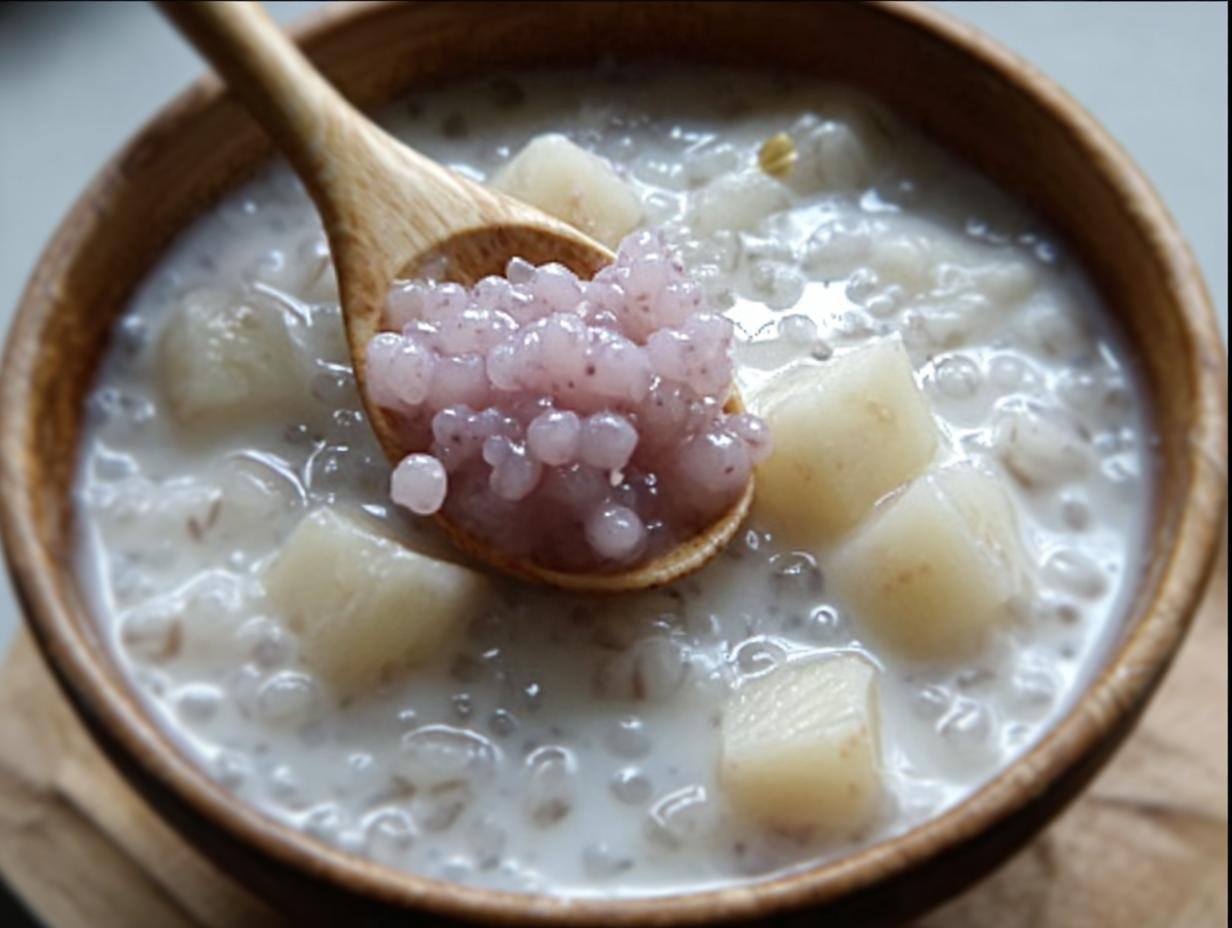Taro coconut sago has a special place in my heart and my kitchen; it’s the ultimate comfort dessert that instantly transports me back to bustling Asian night markets. The moment I inhale that sweet, nutty aroma, I’m reminded of warm evenings and vibrant stalls. I first tasted this amazing taro coconut sago pudding as a child, and the creamy texture of the taro mixed with those chewy tapioca pearls was pure magic. It’s a simple yet incredibly satisfying treat that’s perfect for any occasion, whether you’re craving something warm on a chilly evening or a refreshing chilled dessert. Let’s get cooking!
What is Taro Coconut Sago?
So, what exactly is Taro coconut sago? It’s a delightful Asian dessert that beautifully marries the creamy, slightly sweet flavor of taro root with the richness of coconut milk and the chewy texture of sago pearls. This delightful combination makes it a popular coconut taro sago dessert across many Asian cultures, particularly in Southeast Asia. Its origins are deeply rooted in traditional sweet soups and puddings, evolving over time into the beloved treat we enjoy today. The magic of this dessert lies in its simplicity and the harmonious blend of its core components, creating a truly comforting and satisfying experience with every spoonful of this taro and sago in coconut milk concoction.

Why You’ll Love This Taro Coconut Sago Recipe
You’re going to adore making and devouring this classic dessert. Here’s why it’s a winner:
- Incredibly Creamy Texture: The combination of mashed taro and coconut milk creates a luxuriously smooth base.
- Perfectly Chewy Pearls: The sago pearls add a delightful textural contrast that keeps things interesting.
- Comforting and Sweet: This is the ultimate warm hug in a bowl, perfect for satisfying sweet cravings.
- Versatile Serving Options: Enjoy it warm as a comforting soup or chilled for a refreshing treat.
- Easy to Customize: You can easily adjust the sweetness or add other flavors like pandan.
- Authentic Asian Flavors: This recipe brings the taste of a genuine taro dessert with coconut and sago right to your kitchen.
- Simple Ingredients: Most items are pantry staples or easily found at Asian markets, making this an accessible homemade taro coconut sago.
Ingredients for Creamy Taro Coconut Sago
Gathering your ingredients is the first step toward making a truly wonderful creamy taro coconut sago. I’ve found that using fresh ingredients makes all the difference in this classic Asian dessert. Here’s what you’ll need for this delicious taro sago dessert recipe:
- 1 cup small tapioca pearls (sago) – these are the little chewy gems that make the dessert so fun!
- 1 pound taro root, peeled and cubed – aim for about 1-inch cubes. Fresh taro is key for that authentic flavor and creamy texture.
- 4 cups water – for boiling the sago and taro separately.
- 1 can (14 oz) full-fat coconut milk – this is what gives our dessert its luscious richness and smooth consistency.
- 1/2 cup sugar – adjust this to your personal preference; some like it sweeter, some less so.
- 1/2 tsp salt – a little salt enhances all the other flavors, especially the sweetness and the taro.
- 1 tsp vanilla extract (optional) – adds a lovely subtle aroma and depth of flavor.
- Optional: pandan leaves for fragrance – if you can find them, they add an amazing aromatic quality to your taro and coconut sago milk.
- Optional: condensed milk for extra richness – for an even more decadent treat, a splash of condensed milk is divine.
How to Make the Best Taro Coconut Sago Recipe
Making this delicious taro sago dessert recipe is a rewarding process, and I’ll walk you through each step. While there’s no oven involved, we’ll be using the stovetop to bring all these wonderful ingredients together. Get ready to fill your kitchen with the most amazing aromas!
- Step 1: Cook the Sago Pearls. Bring 4 cups of water to a rolling boil in a medium saucepan. Carefully add the 1 cup small tapioca pearls (sago). Stir them immediately to prevent sticking. Cook for about 10-15 minutes, or until they are mostly translucent with just a tiny white dot in the center. They should look like little glassy jewels. Drain the sago in a fine-mesh sieve and rinse thoroughly under cold running water. This stops the cooking and washes away excess starch, leaving them perfectly chewy. Set them aside.
- Step 2: Prepare the Taro Root. While the sago cooks, peel your 1 pound taro root and cut it into roughly 1-inch cubes. Place the taro cubes in a separate pot, cover with water, and bring to a boil. Cook until the taro is fork-tender, which usually takes about 15-20 minutes. You want it soft enough to mash easily but not mushy. Drain the taro. For a wonderfully creamy texture, mash about half of the cooked taro cubes with a fork or potato masher. Leave the other half cubed for delightful texture in the finished dessert.
- Step 3: Create the Coconut Milk Base. In a clean pot, combine the 1 can (14 oz) full-fat coconut milk, 1/2 cup sugar, and 1/2 tsp salt. Add about 2 cups of fresh water to this mixture. Heat over medium-low heat, stirring gently until the sugar and salt are completely dissolved. Be careful not to let the coconut milk boil vigorously, as it can sometimes split. If you’re using vanilla extract, stir it in now. This forms the luscious, sweet, and slightly salty foundation for our dessert.
- Step 4: Combine and Simmer. Gently stir the cooked sago pearls and the prepared taro (both mashed and cubed) into the coconut milk mixture. Let the dessert simmer gently over low heat for about 5 more minutes, allowing the flavors to meld together beautifully. Stir occasionally to ensure everything is well combined and heated through. This is where the magic happens, transforming simple ingredients into a cohesive and aromatic Asian taro sago with coconut. Taste and adjust the sweetness if needed – this is your chance to perfect your sweet taro sago with coconut!

Cooking the Sago Pearls
To get perfectly chewy sago pearls for your taro coconut sago, boil them in plenty of water until they’re mostly translucent. A quick rinse under cold water after draining is key to preventing them from clumping and achieving that delightful texture.
Preparing the Taro Root
Peel and cube your taro root, then boil it until it’s tender enough to mash easily. For the best texture in your creamy taro coconut sago, mash about half of the cooked taro for creaminess and leave the rest in cubes for delightful bites.
Creating the Coconut Milk Base
Gently heat coconut milk, sugar, and salt with a little water until the sugar dissolves. Avoid boiling coconut milk at high heat to prevent splitting. This creates the rich, sweet, and slightly salty liquid that ties the whole taro and sago in coconut milk dessert together.
Combining and Simmering
Stir the cooked sago and taro into the warm coconut milk base. Let it simmer gently for about five minutes. This allows the flavors to meld into a harmonious and delicious taro coconut sago pudding, making it ready to enjoy.
Pro Tips for the Best Taro Coconut Sago
Achieving that perfect bowl of taro coconut sago is easier than you think with a few insider tricks. These tips will elevate your dessert from good to absolutely unforgettable, ensuring a wonderfully creamy texture and balanced flavor every time you make this delightful Asian taro sago with coconut.
- Use Fresh Taro: Always opt for fresh taro root; frozen or pre-packaged might not yield the same creamy texture or vibrant color.
- Don’t Overcook Sago: Cook sago until just translucent. Overcooking makes them mushy and lose their signature chewy texture.
- Gentle Heat for Coconut Milk: Low and slow is the mantra for coconut milk. High heat can cause it to separate or curdle, ruining the smooth consistency of your sweet taro sago with coconut.
- Balance Sweetness: Taste and adjust sugar as you go. The natural sweetness of taro and the richness of coconut milk should be complemented, not overpowered.
What’s the secret to perfect creamy taro coconut sago?
The secret is in the taro preparation! Mashing about half of the cooked taro root creates a natural thickener, giving your creamy taro coconut sago dessert that luxuriously smooth and velvety texture without needing any artificial thickeners. For more tips on achieving perfect textures in desserts, check out this guide on dessert techniques.
Can I make taro coconut sago ahead of time?
Yes, you absolutely can! You can prepare the components (cook taro and sago, make the coconut base) separately and store them in the refrigerator for up to 2 days. Combine and gently heat everything just before serving for the best texture and flavor.
How do I avoid common mistakes with taro and sago in coconut milk?
To avoid mushy sago, rinse them thoroughly under cold water after cooking. For the coconut milk, always use low to medium heat to prevent splitting. Ensure your taro is tender but not falling apart before mashing for that perfect consistency in your taro and sago in coconut milk. If you’re interested in other dessert recipes that require careful texture management, explore our collection.
Best Ways to Serve Taro Coconut Sago
This versatile dessert is a delight served in so many ways! For a comforting treat, enjoy your taro coconut sago pudding warm, especially on a cooler evening. It’s incredibly soothing and satisfying. If you prefer something more refreshing, chill it for a few hours until cold. This makes it a perfect palate cleanser after a rich meal or a lovely light dessert on a warm day. You can also serve it alongside fresh fruit like mango or jackfruit for an extra burst of tropical flavor. This sweet taro sago with coconut is also wonderful paired with other light Asian desserts. For inspiration on pairing desserts, consider exploring culinary pairings.
Taro Coconut Sago Nutritional Information
Here’s a look at the estimated nutritional breakdown for a serving of this delicious taro coconut sago pudding. Remember that these values can vary based on the exact ingredients and portion sizes used in your preparation.
- Calories: Approximately 300-350
- Fat: 15-20g
- Saturated Fat: 12-15g
- Protein: 3-5g
- Carbohydrates: 40-50g
- Fiber: 3-5g
- Sugar: 25-35g
- Sodium: 100-150mg
Nutritional values are estimates and may vary based on specific ingredients used and portion sizes.
How to Store and Reheat Taro Coconut Sago
Properly storing your delicious homemade taro coconut sago ensures you can enjoy this comforting dessert for days to come. Once it has cooled down completely to room temperature, transfer your creamy taro coconut sago into an airtight container. I find that glass containers work best for this. You can keep it stored in the refrigerator for about 3 to 4 days. If you want to keep it even longer, freezing is a great option for your taro coconut sago pudding. For best results, freeze individual portions in small airtight containers or freezer bags for up to 3 months.
When you’re ready to enjoy your stored dessert, reheating is simple. For a warm bowl of sweet taro sago with coconut, gently warm it on the stovetop over low heat, stirring occasionally until heated through. You can also microwave it in short bursts, stirring in between. If you prefer it chilled, simply thaw frozen portions in the refrigerator overnight and then enjoy it cold. Remember, the texture of the sago pearls might change slightly after freezing and reheating, but the flavor remains wonderfully comforting.
Frequently Asked Questions About Asian Taro Sago with Coconut
What is the difference between taro and ube?
While both are root vegetables with purple flesh, taro has a more subtle, nutty, and slightly earthy flavor, while ube is distinctly sweeter with vanilla-like notes. This recipe uses taro for its authentic, less sweet profile in our Asian taro sago with coconut. For more information on root vegetables, you can explore resources on nutritional powerhouses.
Can I use pre-cooked taro or canned taro?
For the best flavor and texture in your taro coconut sago pudding, fresh taro is highly recommended. Canned taro can be mushy and lack the distinct flavor. If you must use canned, look for chunks in water and drain them very well, but the result won’t be as vibrant.
My sago pearls are clumpy, what did I do wrong?
This usually happens if you don’t stir them immediately after adding them to boiling water, or if you don’t rinse them well afterward. Rinsing under cold water is crucial to remove excess starch and prevent clumping in your taro and sago in coconut milk dessert.
Is taro coconut sago healthy?
This taro dessert with coconut and sago can be part of a balanced diet. Taro root itself is a good source of fiber and nutrients. However, the addition of sugar and full-fat coconut milk increases the calorie and fat content. You can make it healthier by reducing the sugar or using light coconut milk, but it will alter the classic taste. For healthier dessert options, consider fruit-based crumbles.
Variations of Sweet Taro Sago with Coconut You Can Try
Once you’ve mastered the classic, you might want to experiment with this wonderful sweet taro sago with coconut. There are so many delicious ways to adapt this recipe to suit your preferences or dietary needs. Here are a few ideas to inspire your next batch of taro coconut sago pudding.
- Vegan/Dairy-Free: This recipe is naturally dairy-free if you use full-fat coconut milk! For an even richer vegan version, you can add a splash of sweetened condensed coconut milk.
- Reduced Sugar: If you prefer a less sweet dessert, significantly cut back on the sugar. The natural sweetness of the taro and coconut milk is often enough for many palates, making your creamy taro coconut sago lighter.
- Flavor Infusions: Add a strip of pandan leaf while simmering the coconut milk base for an incredible fragrant aroma. A little bit of vanilla extract or a dash of cinnamon can also add interesting depth to your taro dessert with coconut and sago.
- Chilled Dessert Bowls: Instead of serving it as a soup, chill the mixture completely and serve it in small bowls with a drizzle of coconut cream or some fresh fruit for a beautiful, refreshing dessert presentation.
Amazing Taro Coconut Sago: 5 Star Comfort Dessert
Taro Coconut Sago is a creamy Asian dessert made with chewy tapioca pearls, tender taro root, and rich coconut milk. Sweet, comforting, and versatile, it can be served warm or chilled, making it one of the most beloved taro desserts across Asia.
- Prep Time: 15 minutes
- Cook Time: 30 minutes
- Total Time: 45 minutes
- Yield: 4 – 6 servings 1x
- Category: Dessert, Asian Sweets
- Method: Boiling, Simmering
- Cuisine: Asian, Thai, Chinese
- Diet: Vegetarian
Ingredients
- 1 cup small tapioca pearls (sago)
- 1 pound taro root, peeled and cubed
- 4 cups water (for boiling separately)
- 1 can (14 oz) coconut milk
- 1/2 cup sugar (adjust to taste)
- 1/2 tsp salt
- 1 tsp vanilla extract (optional)
- Optional: pandan leaves for fragrance, or condensed milk for extra richness
Instructions
- Cook Sago: Boil water, add tapioca pearls, and cook 10–15 minutes until translucent. Drain, rinse under cold water, and set aside.
- Cook Taro: Peel and cube taro. Boil until tender, about 15–20 minutes. Mash half for creaminess, leave half cubed for texture.
- Make Coconut Base: In a pot, combine coconut milk, sugar, salt, and 2 cups water. Heat gently, stirring until sugar dissolves. Add vanilla if using.
- Combine: Stir in cooked sago and taro. Simmer 5 minutes until creamy. Adjust sweetness as needed.
- Serve: Enjoy warm as a dessert soup, or chill for 2–3 hours for a refreshing cold version.
Notes
- Stir sago while cooking to prevent clumping.
- Use fresh taro for the best flavor and texture.
- Do not boil coconut milk at high heat—it may split.
- Balance sweetness carefully to highlight the nutty taro flavor.
- Mash half the taro for creaminess, keep some cubes for texture.
Nutrition
- Serving Size: 1 bowl













Leave a Reply